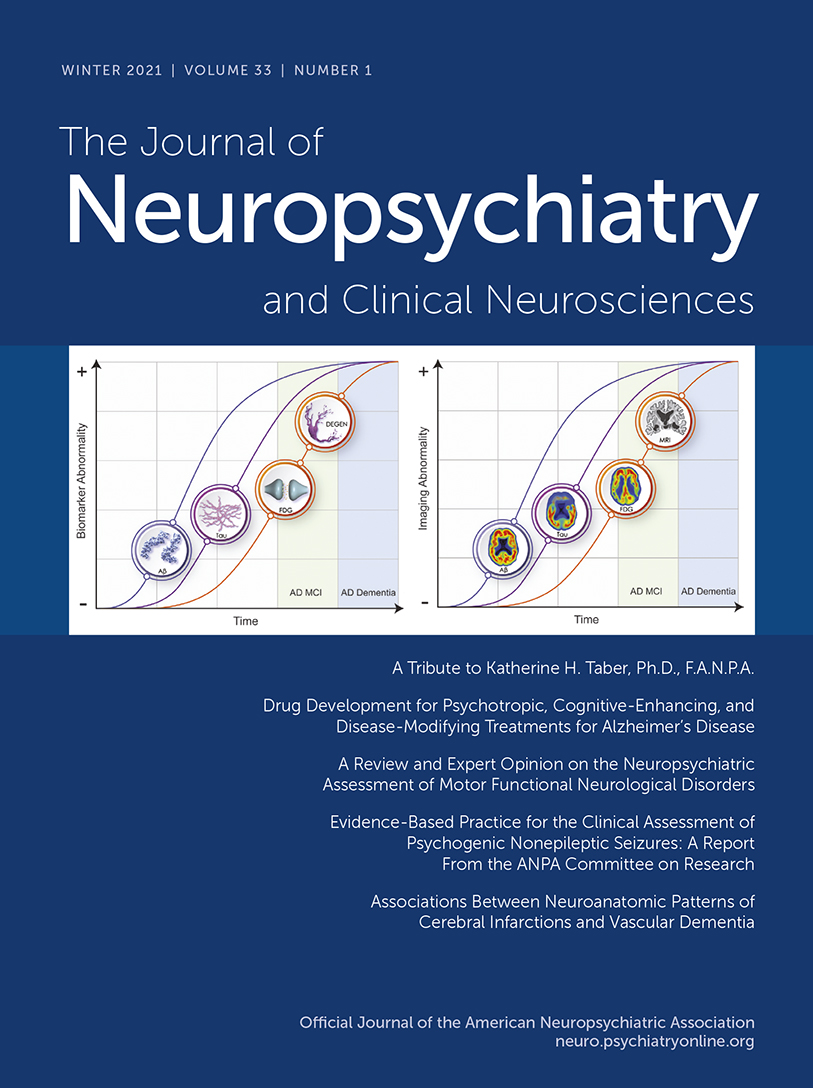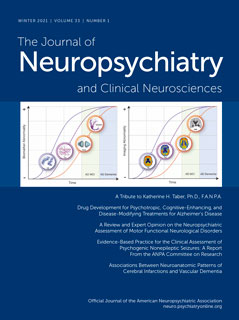A Review and Expert Opinion on the Neuropsychiatric Assessment of Motor Functional Neurological Disorders
Abstract
Approach
Review: State of the Evidence
Clinical Interview
Illness Onset
Demographic characteristics.
Tempo.
Precipitating factors.
Illness Course and Clinical Presentation
Medical and Family Histories
Other Psychosocial Factors
Past Maltreatment and Other Stressors
Categorical Psychiatric Comorbidities and Dimensional Characteristics
Illness Perceptions
Suicidality and Self-Harm
Personality Disorders and Dimensional Assessments
| Variable | Description |
|---|---|
| Age at onset (years) | Symptom onset usually occurs between 39 and 49 years old (mean range), with a female predominance. It also can occur in pediatric and geriatric populations. |
| Tempo of onset | Sudden onset occurs in a majority of cases (>50%). |
| Precipitating factors | A precipitating factor occurring in close temporal proximity with symptom onset can often be identified (48%–80%), such as injuries, accidents, surgeries, other medical procedures, and emotionally valenced events. |
| Associated functional neurological symptoms | Mixed functional motor symptoms are common in adults and especially in children (50%–75%). |
| Other associated physical symptoms | Comorbid pain, fatigue, dizziness, gastrointestinal complaints, sleep difficulties, and cognitive symptoms are common. |
| Illness course | The illness course can show waxing and waning patterns, including periods of spontaneous remissions. |
| Medical comorbidities | In adults, FND can coexist with other medical and neurological conditions, including, for example, another movement disorder (17%–25%). Medical comorbidities are less common among children. |
| Family history | Neurological and/or psychiatric disorders can be found in the family. A maternal history of depression and/or anxiety is common in pediatric populations. |
| Psychosocial history | Childhood maltreatment (abuse and neglect) is commonly identified but not universally present. Stressful family dynamics or scholastic challenges are relevant themes in pediatric FND. |
| Psychiatric comorbidities | In adults, comorbid psychiatric conditions are frequently present (major depression [35%–42%], generalized anxiety disorder [7%–23%], panic disorder [3%–36%], posttraumatic stress disorder [0%–24%], somatization disorder [22%–27%], and personality disorders [20%–30%]). In children, mood disorders (9%–16%) and anxiety disorders (18%–100%) are common. |
Neurological Examination: Rule-In Signs
| Sign |
|---|
| General signs |
| Distractibility |
| Variability (e.g., difference in symptom severity between history taking and examination) |
| Suggestibility |
| Gait |
| Dragging monoplegic gait |
| Knee buckling |
| Noneconomic posture |
| Tremor |
| Variability |
| Distractibility |
| Entrainment |
| Spread of tremor to another body part if the tremor is restrained |
| Jerks |
| Predominantly axial |
| Distractibility |
| Variability |
| Parkinsonism |
| Excessive slowness without loss of amplitude |
| Increased tone without cogwheel rigidity |
| Concurrent functional tremor |
| Dystonia |
| Fixed posture (typically hand flexion with sparing of digits 1 and 2 or fixed ankle inversion) |
| Lack of sensory trick/geste antagoniste |
| Tics |
| No voluntary suppression |
| No or atypical/incomplete premonitory urge |
| Movements not stereotypical |
| Weakness |
| Hoover sign/hip abductor sign |
| Spinal Injuries Center sign |
| Asymmetry of head rotation |
| Arm drift without pronation |
| Giveway/collapsing and/or global pattern of weakness |
Adjunctive Tests
Electromyography (EMG) and Accelerometry
EEG
Transcranial Magnetic Stimulation (TMS)
Neuroimaging
Other Tests
Discussion
Initial Neuropsychiatric Assessment for Motor FND
Clinical History (Table 1)
Other Medical and Psychiatric Histories
Psychosocial History
Illness Perceptions and Health Care Experiences
Cautionary Notes Regarding Clinical History
Physical Examination Signs (Table 2)
Adjunctive Tests (Table 3)
| Test | Description |
|---|---|
| Surface electromyography (EMG) | May be useful to detect electrophysiological features consistent with functional tremor and functional myoclonus. |
| Accelerometry | May be combined with EMG data for characterization of features supportive of functional tremor. |
| EEG | Can aid the diagnosis of functional myoclonus by demonstrating the Bereitschaftspotential prior to a jerk. |
| Single-photon emission computed tomography DaTScan | Can assist in detecting a basal ganglia dopaminergic deficit found in Parkinson’s disease. |
Other Comments
Future Directions and Conclusions
Footnote
Supplementary Material
- View/Download
- 39.71 KB
- View/Download
- 39.71 KB
References
Information & Authors
Information
Published In
History
Keywords
Authors
Funding Information
Metrics & Citations
Metrics
Citations
Export Citations
If you have the appropriate software installed, you can download article citation data to the citation manager of your choice. Simply select your manager software from the list below and click Download.
For more information or tips please see 'Downloading to a citation manager' in the Help menu.
View Options
View options
PDF/EPUB
View PDF/EPUBLogin options
Already a subscriber? Access your subscription through your login credentials or your institution for full access to this article.
Personal login Institutional Login Open Athens loginNot a subscriber?
PsychiatryOnline subscription options offer access to the DSM-5-TR® library, books, journals, CME, and patient resources. This all-in-one virtual library provides psychiatrists and mental health professionals with key resources for diagnosis, treatment, research, and professional development.
Need more help? PsychiatryOnline Customer Service may be reached by emailing [email protected] or by calling 800-368-5777 (in the U.S.) or 703-907-7322 (outside the U.S.).

